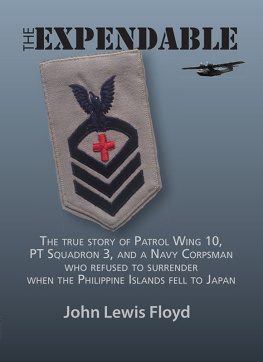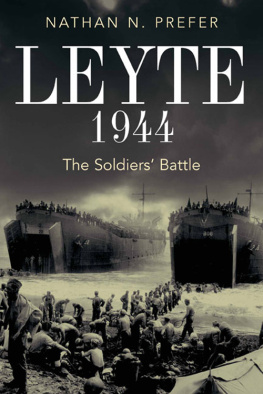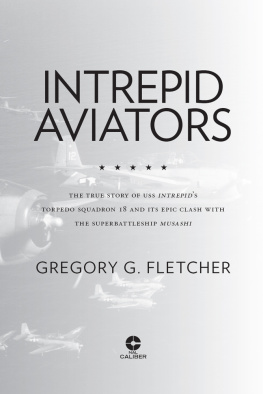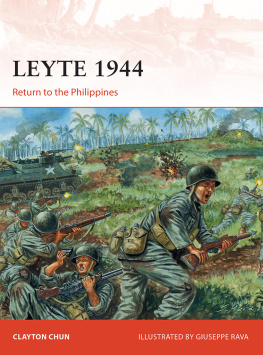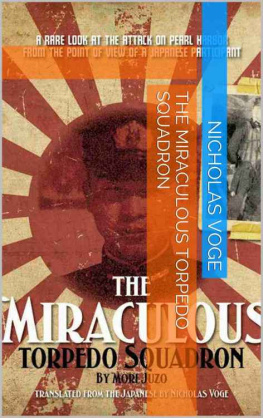Published in the United States of America and Great Britain in 2016 by
CASEMATE PUBLISHERS
1950 Lawrence Road, Havertown, PA 19083, USA
and
10 Hythe Bridge Street, Oxford OX1 2EW, UK
Copyright 2016 John J. Domagalski
Hardcover Edition: ISBN 978-1-61200-407-5
Digital Edition: ISBN 978-1-61200-409-9
A CIP record for this book is available from the Library of Congress and the British Library
All rights reserved. No part of this book may be reproduced or transmitted in any form or by any means, electronic or mechanical including photocopying, recording or by any information storage and retrieval system, without permission from the publisher in writing.
Printed and bound in the United States of America
For a complete list of Casemate titles, please contact:
CASEMATE PUBLISHERS (US)
Telephone (610) 853-9131
Fax (610) 853-9146
Email:
www.casematepublishers.com
CASEMATE PUBLISHERS (UK)
Telephone (01865) 241249
Fax (01865) 794449
Email:
www.casematepublishers.co.uk
PROLOGUE
WAR COMES TO THE PHILIPPINES
A ringing telephone pierced the night-time silence in the officers quarters at the Cavite Navy Yard. The largest American naval base in the Philippines was positioned on the very end of Stanley Pointa small finger of land that jutted out into Manila Bay from the mainland. About 8 miles across the water to the northeast was Manila, capital of the American Commonwealth and a majestic city long known as the Pearl of the Orient.
A sleepy Lieutenant John D. Bulkeley turned on a bedside lamp. The young officer had been in the Philippines for less than three months. He commanded Motor Torpedo Boat (MTB) Squadron 3. The unit comprised six small wooden torpedo boats, commonly known as PT boats, and about eighty men.
A glimpse at his watch revealed it was a few minutes after 3:00 am. Bulkeley picked up the receiver to the sound of an excited voice. Were at war! the caller exclaimed before continuing with some stunning news. The Japs have just bombed Pearl Harbor. The Old Man wants you to get down here, right away. Bulkeley knew exactly what it meant. The Old Man was Rear Admiral Francis Rockwell, commander of the Sixteenth Naval District. Rockwell oversaw an assortment of naval bases in the Philippines and some local defense forces.
Bulkeley was now wide awake. He shook one of his officers, Ensign Anthony Akers, and told him the news. Akers though it was a joke. This is a hell of a time to be declaring war! he mumbled, and rolled over.
The start of the war came as no surprise to Bulkeley, who like most servicemen in the Pacific knew tensions between the U.S. and Japan had reached a boiling point, but where it began was a shock. He thought the first shots would be fired somewhere near where he was in the Far East. It was December 8, 1941 in the Philippines. Over 5,100 miles to the east and a day earlier, due to crossing the International Date Line, the Japanese had launched a surprise attack on the Pacific Fleet in Pearl Harbor, Hawaii, with planes from aircraft carriers. The biggest American naval and air facility in the Pacific had been taken by complete surprise. The fleet sustained serious damage as the United States was abruptly thrust into World War II.
Bulkeley ran out to a jeep after quickly putting on some clothes. He then began making his way to the Commandantia. The old thick-walled fortress of a building from Spanish colonial days served as Rockwells headquarters on Stanley Point.
Rockwell was notified of the start of war by his immediate superior. Admiral Thomas Hart, Commander in Chief of the United States Asiatic Fleet, was the first high-level American leader in the Philippines to receive news of the Pearl Harbor attack. Hart was in command of all naval forces in and around the Philippines. Marine Lieutenant Colonel William Clement had called Hart, telling him to put some cold water on your face. He arrived at the admirals residence in Manila a short time later carrying a simple plain language message from the Navy in Hawaii. Air raid on Pearl Harbor. This is no drill.
Sitting on his bedside, Hart drafted a brief message for Clement to immediately send out to all units of the Asiatic Fleet. Japan started hostilities. Govern yourselves accordingly. The dispatch went out at 3:27 am. He did not, however, send the message to the army command in the Philippines, although he later dispatched his chief of staff to army headquarters.
It did not take long for Bulkeley to reach the Commandantia. He rushed into the headquarters to find Admiral Rockwell fully dressed along with his chief of staff, Captain Harold Ray. Dawn was just beginning to break over Manila Bay. The grim-faced Rockwell was calmly staring at the sky. They ought to be here any minute, he said, referring to the Japanese bombers he was certain were en route. The admiral did not want the PT boats to stay at Cavite as it was too risky in the event of an air attack. He ordered Bulkeley to get his boats ready for sea and then go across Manila Bay to Mariveles Harbor.
At about the same time Bulkeley was leaving the Commandantia, a ringing bedside telephone awoke General Douglas MacArthur. The general commanded all American army and army air force personnel in the Philippines. He resided in a lavish penthouse suite at the opulent Manila Hotel in the downtown area of the capital city. MacArthur picked up the receiver to hear the voice of his chief of staff, Major General Richard Sutherland, who told him the war had started.
The Army learned the news not from the Navy, but when an enlisted signalman picked up an electrifying flash news bulletin about the Pearl Harbor attack from a commercial radio station in San Francisco. Pearl Harbor! MacArthur exclaimed in disbelief. It should be our strongest point!
The telephone rang again as the general rushed to get dressed. This time it was Brigadier General Leonard Gerow. The chief of the Armys war plans division was calling from Washington, D.C. to confirm the news bulletin. The general was ordered to execute the prearranged war plan. I wouldnt be surprised if you get an attack there in the near future, Gerow warned. MacArthur replied that his forces were on alert and ready for action. However, the coming days would call into question this statement. He then read the bible for ten minutes, as he customarily started every morning, before heading out to his headquarters.
MacArthur arrived at his office to a chaotic scene. Officers and staff members were trying to gather accurate information from Pearl Harbor and determine Japanese movements in order to ascertain the true situation in the Pacific. The question was not if an attack was coming, but when. The Japanese were certain to strike the Philippines by air, sea, or both. It would be up to MacArthur alone, however, to determine how to respond to the impending action.
The PT boats under John Bulkeleys command were among the Navys fastest and newest weapons. So new, in fact, that formal operational tactics had not yet been developed. The squadron commander knew he would be creating the tactics as he went along, in wartime conditions.



